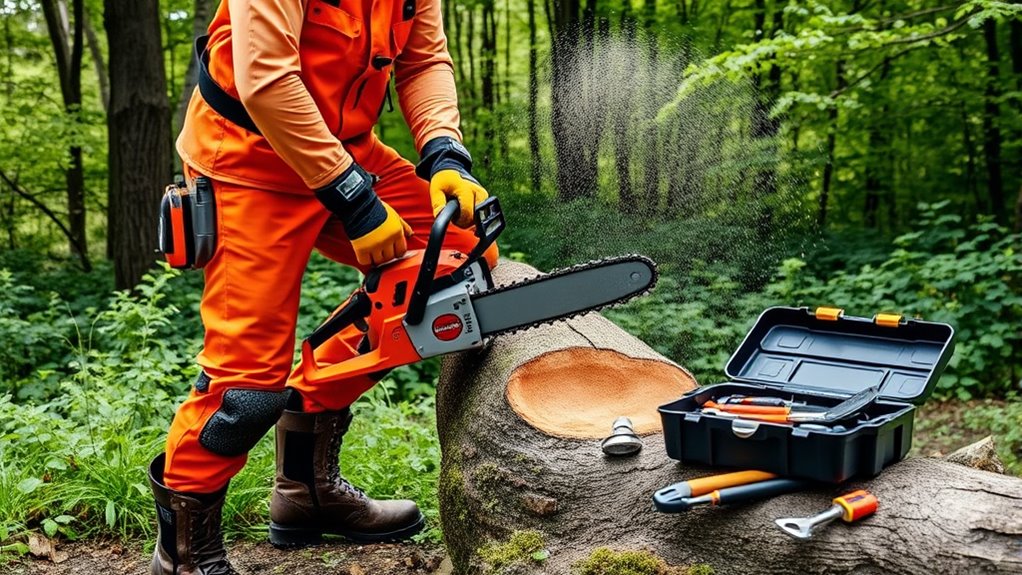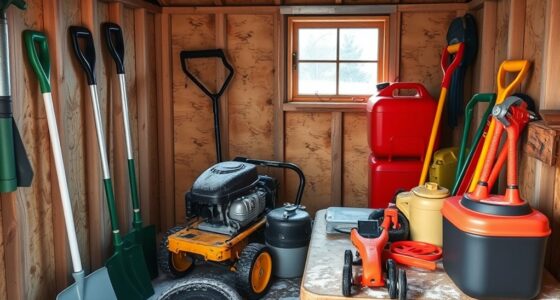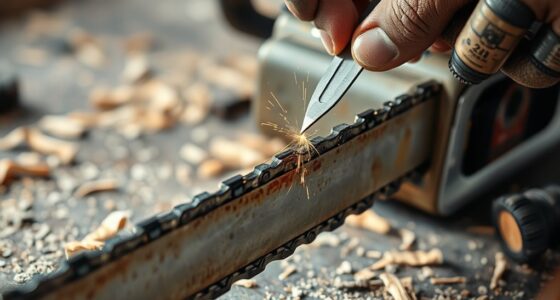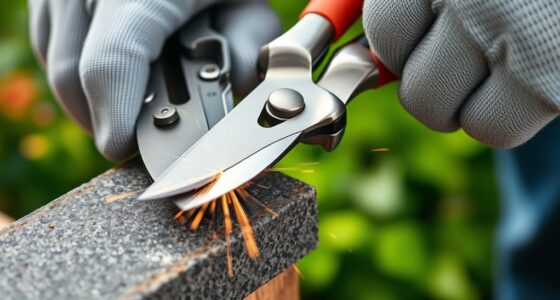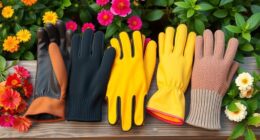To operate and maintain a chainsaw safely, always check and inspect your equipment beforehand—ensure the chain is sharp, tensioned correctly, and safety features like the chain brake are working. Wear proper protective gear, including gloves, eye protection, hearing muffs, and sturdy clothing. Use correct handling techniques, plan your cuts carefully, and maintain regular maintenance like sharpening and fueling properly. Following these safety steps helps prevent accidents and keeps your chainsaw in good shape; learning more will help you become confident and safer during use.
Key Takeaways
- Conduct thorough pre-operation safety checks, including chain tension, sharpness, and safety feature functionality.
- Always wear appropriate personal protective gear like gloves, eye protection, hearing protection, and sturdy clothing.
- Use proper cutting techniques with stable posture, controlled movements, and clear work areas to prevent kickback and accidents.
- Regularly maintain your chainsaw by lubricating the chain, inspecting the bar, sharpening or replacing the chain, and cleaning filters.
- Store fuel and equipment safely, drain fuel before storage, and transport the saw in protective covers to prevent leaks and injuries.
Understanding Your Chainsaw: Types and Features
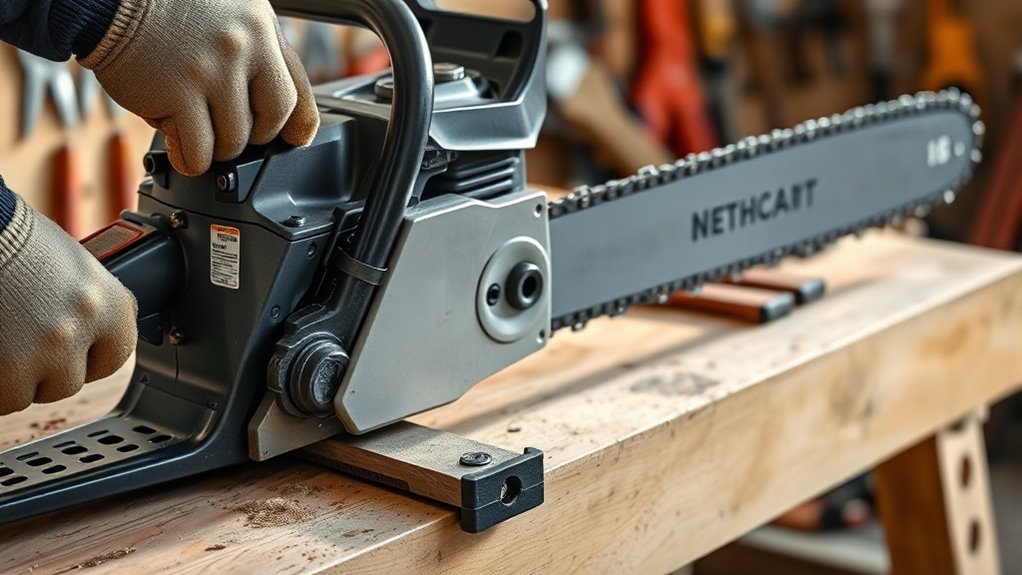
Understanding your chainsaw begins with knowing the different types and their features. Chain saw engine types vary, including two-stroke engines, which are lightweight and powerful, and four-stroke engines, offering quieter operation and better fuel efficiency. Your choice depends on your cutting needs and comfort. Bar length options also matter; shorter bars (16-20 inches) are ideal for pruning and small tasks, while longer bars (24 inches and above) handle larger logs and heavy-duty cutting. Recognizing these features helps you select the right chainsaw for your projects, ensuring safety and efficiency. Knowing the engine type and bar length will guide you in operating your chainsaw correctly and maintaining it properly, reducing risks and extending its lifespan. Additionally, understanding sound vibrations can help you operate your chainsaw more safely and comfortably.
Personal Protective Equipment for Chainsaw Use
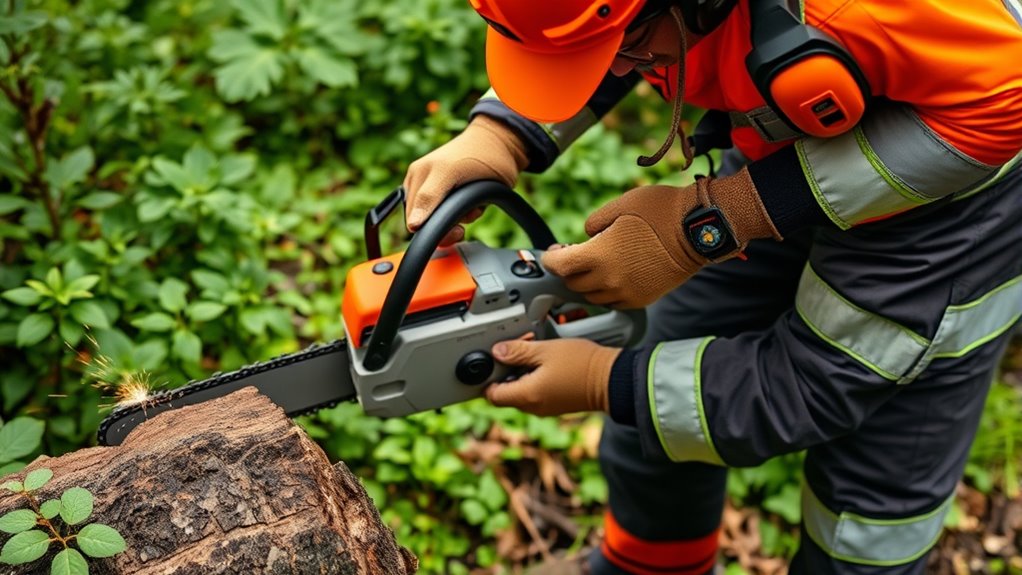
When you operate a chainsaw, wearing the right safety gear is essential to protect yourself from injury. Proper clothing choices, like long sleeves and sturdy pants, help shield your skin from cuts and debris. Make sure you also have the necessary protective equipment to stay safe during every cut. Utilizing personal protective equipment such as gloves, eye protection, and hearing protection further reduces the risk of accidents and injuries.
Essential Safety Gear
Wearing the right safety gear is essential to protect yourself from the hazards of using a chainsaw. Your chainsaw grip should be secure, so choose gloves that provide a firm hold and prevent slipping. Proper gloves also shield your hands from cuts and vibrations. Noise protection is equally important; always wear ear muffs or ear plugs to prevent hearing damage from prolonged exposure to loud engine noise. Safety glasses or a full-face shield will guard your eyes from flying debris and wood chips. A helmet with a face shield adds extra protection against falling branches or accidental contact with the saw. Remember, these safety essentials considerably reduce the risk of injury and help you operate confidently and safely. Additionally, understanding proper chainsaw maintenance techniques can prevent accidents caused by equipment failure.
Proper Clothing Choices
Choosing the right clothing is vital to stay safe while operating a chainsaw. Protective gear and clothing materials play a fundamental role in preventing injuries. To guarantee proper protection, consider these items:
- Chainsaw chaps or pants made from cut-resistant materials
- A hard hat with face shield or safety goggles
- Heavy-duty gloves designed for forestry work
- Steel-toe boots with non-slip soles
Wearing gear made from durable, protective clothing materials helps absorb impact and resist cuts. Always choose clothing that fits well and covers your arms and legs completely. Avoid loose clothing that could get caught in the chainsaw. Proper clothing choices reduce injury risk and boost your confidence during operation. Remember, investing in quality protective gear is key to safe chainsaw use. Additionally, choosing electric chainsaws over gas-powered models can reduce noise and emissions, making work safer and more environmentally friendly.
Pre-Operation Safety Checks and Inspection
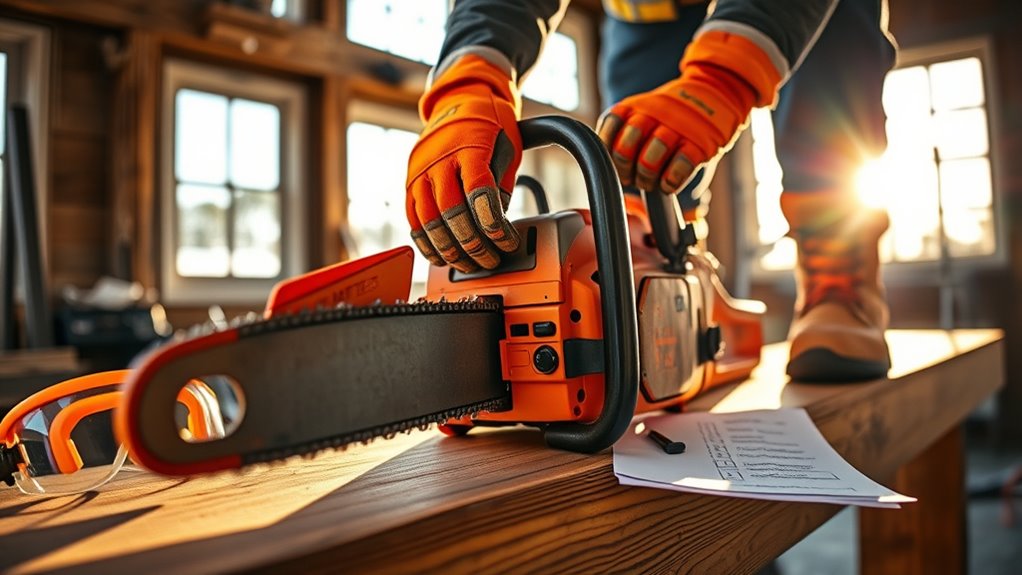
Before starting your chainsaw, you need to perform quick safety checks. Make sure the chain tension is correct, the blade is sharp, and all safety features are working properly. These steps help prevent accidents and ensure your saw operates smoothly. Regular maintenance and understanding Kia Tuning options can also contribute to safer and more efficient operation of your equipment.
Inspect Chain Tension
Have you checked the chain tension lately? Proper tensioning prevents accidents and ensures efficient cuts. To inspect, follow these steps:
- Turn off the saw and let it cool.
- Use tensioning tools or your fingers to check the slack.
- The chain should be snug but move freely without sagging.
- Adjust the chain tension if needed by using the chain tension adjustment knob or screw.
Always verify the chain isn’t too tight, which can cause damage, or too loose, risking derailment. Use tensioning tools for precise adjustments, and recheck the tension after tightening. Proper chain tension is essential for safe, smooth operation, so don’t skip this step before each use.
Examine Blade Sharpness
Ensuring your saw’s blade is sharp before starting work helps prevent accidents and improves cutting efficiency. Proper blade maintenance focuses on the cutting edge, making sure it’s sharp enough to cut smoothly. A dull blade requires more force, increasing the risk of slips or kickbacks. To examine blade sharpness, inspect the cutting edge for any nicks, dents, or dull spots. If the blade appears rounded or the teeth are no longer pointed, it’s time to sharpen or replace it. Maintaining a sharp blade also reduces stress on the saw motor and prolongs its lifespan. Regular inspections before each use help identify dullness early, ensuring safe, effective operation. Remember, a sharp blade is essential for safe, efficient chainsaw work. Proper maintenance practices are vital for ensuring consistent safety and performance.
Check Safety Features
Checking safety features before starting your chainsaw is essential to guarantee it operates safely and effectively. A thorough feature inspection helps prevent accidents and ensures chainsaw safety. First, verify that the chain brake engages properly—this stops the chain during kickbacks or emergencies. Second, ensure the throttle lockout works, preventing accidental acceleration. Third, inspect the chain tension; a loose chain can derail and cause injury. Fourth, confirm that the chain catcher is intact and securely attached, catching the chain if it derails. Regularly checking these safety features minimizes risks and maintains ideal performance. Always perform this inspection before each use to protect yourself and those around you, emphasizing chainsaw safety and reliable feature functioning. Additionally, using high-quality sound recording equipment can help document and analyze chainsaw operation for training or safety reviews.
Proper Starting and Handling Techniques
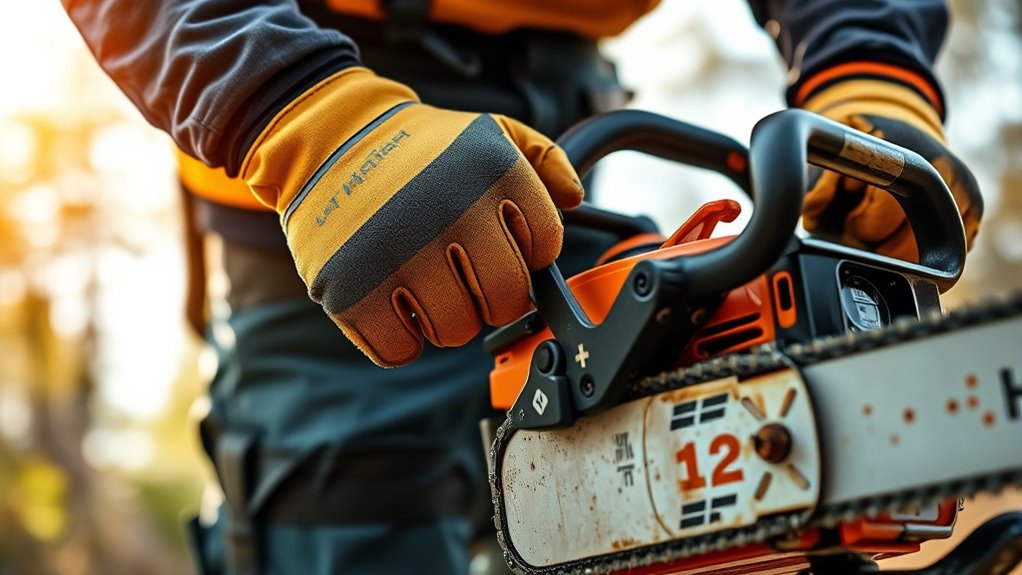
To start your chainsaw safely, you need to follow proper techniques that guarantee smooth operation. First, verify good chainsaw ergonomics by maintaining a stable stance and gripping the saw firmly but comfortably. Before starting, check the fuel mixture tips: use the correct ratio of fuel to oil, and mix thoroughly to prevent engine issues. Place the chainsaw on a flat surface or secure it in your hand with the chain brake engaged. When starting, activate the chain brake, set the saw to choke if cold, and pull the starter cord steadily. Keep your body clear of the chain path. Proper handling during startup minimizes kickback risks and promotes control, allowing you to operate safely and efficiently throughout your task. Additionally, understanding the performance metrics of your chainsaw, such as engine power and chain speed, can help you handle the tool more effectively and safely.
Safe Cutting Practices and Techniques
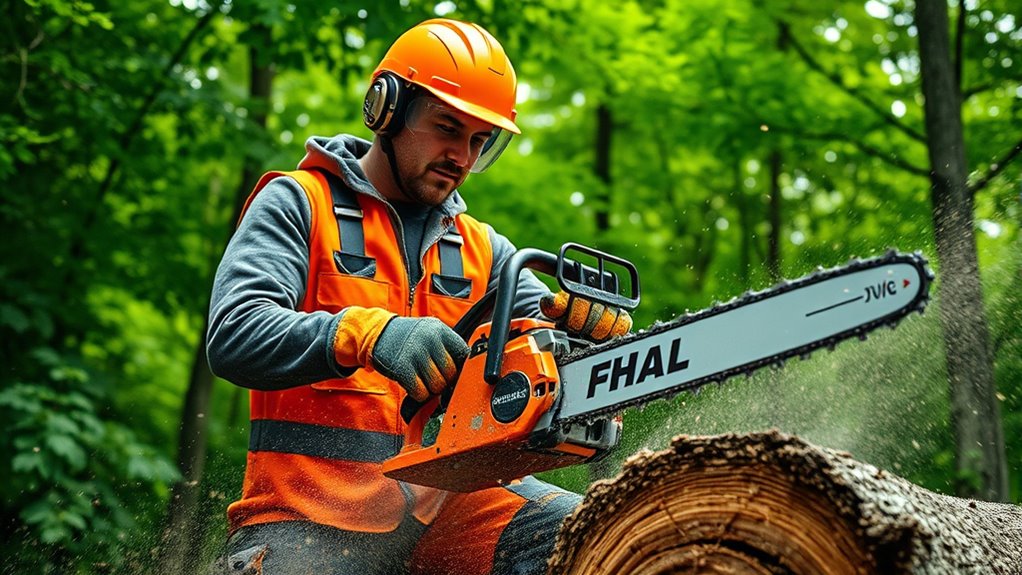
To cut safely with a chainsaw, maintaining proper posture is essential; stand with your feet shoulder-width apart and keep your grip firm. Use controlled, deliberate movements to guide the saw, avoiding sudden or jerky motions. This approach helps prevent accidents and guarantees cleaner, more precise cuts. Additionally, understanding the principles of comparative advantage can inform efficient resource use in equipment maintenance and operation.
Proper Cutting Posture
Maintaining proper cutting posture is essential for safe and efficient chainsaw operation. Your stance influences control, reduces fatigue, and prevents injuries. To achieve an ergonomic stance, keep these tips in mind:
- Stand with feet shoulder-width apart for stability.
- Keep your knees slightly bent to absorb shocks.
- Maintain a firm grip with both hands, elbows slightly bent.
- Lean slightly forward, not overextending, to keep the cutting posture balanced.
- Regularly review and adjust your technique to ensure optimal safety, similar to how personal finance management recommends periodic plan reviews.
Controlled Cutting Movements
Practicing controlled cutting movements is essential for safety and efficiency when operating a chainsaw. Using proper felling techniques helps you control the direction of the fall and reduces risks. Always plan your cuts carefully, making sure your footing is secure and the area is clear. When performing limb removal, make precise, deliberate cuts to avoid kickback or unpredictable movements. Use controlled motions to guide the chainsaw smoothly through the wood, avoiding sudden jerks or overreaching. Keep your cuts steady and consistent, paying attention to the tension in the branch or trunk. By maintaining control during every cut, you minimize hazards and ensure clean, safe operation. Mastering these controlled movements makes your work safer and more effective. Additionally, understanding the market trends and regulations surrounding cryptocurrencies can influence your decision-making in related industries.
Routine Maintenance Tasks for Longevity and Safety
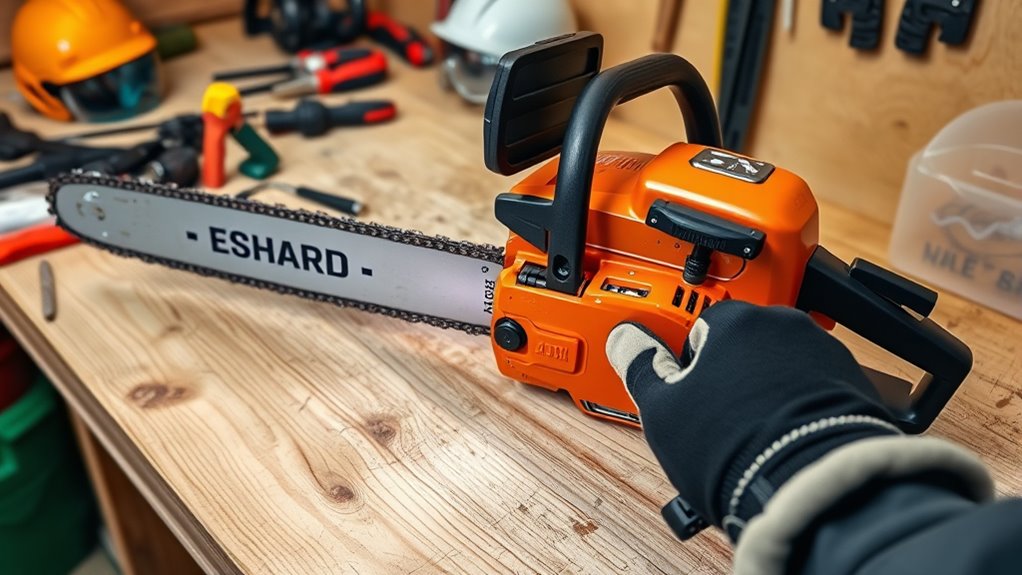
Regularly performing routine maintenance tasks is essential for keeping your chainsaw operating safely and efficiently. Proper care guarantees longevity and peak performance. Focus on these key tasks:
- Check and apply chain lubrication regularly to prevent overheating and wear.
- Inspect the bar for damage or uneven wear, and perform bar maintenance as needed.
- Clean the air filter to keep the engine running smoothly.
- Tighten loose nuts and bolts to maintain stability during operation.
- Ensure proper airflow around the chainsaw to enhance cooling and prevent dust buildup air purifier maintenance.
Sharpening and Replacing the Chain

Have you noticed your chainsaw struggling to cut smoothly or producing more sawdust than usual? That’s a sign it’s time for chain sharpening. Dull chains reduce cutting efficiency and increase safety risks. To sharpen the chain, use a file guide and a round file to carefully hone each tooth, maintaining the proper angle. If sharpening doesn’t restore cutting performance, it’s time for chain replacement. Regularly inspect your chain for signs of damage, such as chipped or missing teeth, and replace it promptly to avoid accidents. Always ensure the chain is properly tensioned after sharpening or replacing, and double-check that the chain brake is engaged before handling. Proper maintenance of your chain keeps your chainsaw efficient and safe to operate. Additionally, understanding the correct chain tension is essential for optimal performance and safety.
Fueling and Chain Oil Management

Proper fueling and chain oil management are essential for keeping your chainsaw running smoothly and safely. Making sure the correct fuel mixture and proper chain lubrication prevents damage and enhances performance. Here’s what you should do:
- Use the right fuel mixture, typically 50:1 (gas to oil), for peak engine function.
- Always fill the fuel tank with fresh, clean fuel to avoid engine issues.
- Apply chain oil regularly to ensure proper chain lubrication, reducing wear and tear.
- Check the chain oil level before each use, topping it up as needed to maintain consistent lubrication.
- Maintaining proper trust and communication with your equipment ensures optimal operation and safety.
Recognizing and Troubleshooting Common Issues
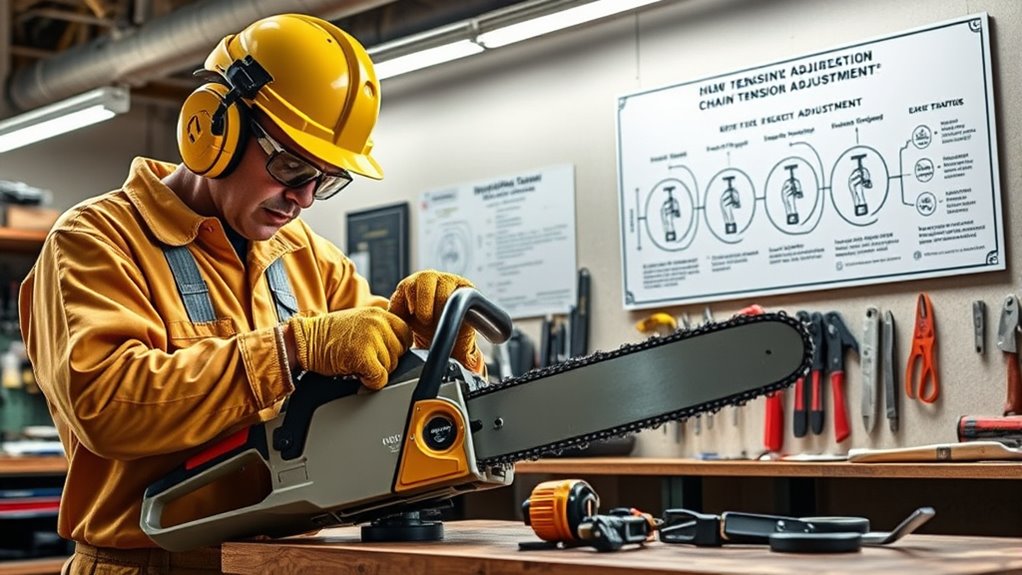
Identifying common chainsaw issues early can save you time and prevent accidents. If your chainsaw won’t start, check the chain brake—sometimes it’s engaged or stuck, blocking engine engagement. Excessive vibrations may indicate loose or damaged parts, or inadequate vibrational damping, which can lead to operator fatigue or handle damage. If the chain is not cutting smoothly, inspect for dull or broken teeth and ensure proper chain tension. Sudden power loss might stem from fuel or spark problems, so verify fuel quality and spark plug condition. Unusual noises or excessive smoke could signal oil or engine issues. Regularly inspecting these signs helps you troubleshoot effectively, keeping your chainsaw running safely and efficiently while avoiding potential hazards.
Storing and Transporting Your Chainsaw Safely

Storing and transporting your chainsaw correctly is essential for safety and equipment longevity. Proper storage environments protect your chainsaw from damage and corrosion, while using the right chainsaw accessories ensures safe handling. To keep your chainsaw in top shape:
- Drain fuel and oil before storing to prevent leaks.
- Store in a dry, secure location away from children and pets.
- Use protective cases or covers to prevent accidental injuries.
- Transport with the guide bar’s chain secured or covered to avoid injuries.
Always inspect your chainsaw accessories like chainsaw guards and safety latches before storage. When moving your chainsaw, ensure it’s turned off, cooled down, and properly secured in a vehicle to prevent accidents. Proper storage and transport maintain safety and extend your chainsaw’s lifespan.
Frequently Asked Questions
How Often Should I Replace My Chainsaw’s Safety Features?
You should replace your chainsaw’s safety features whenever they show signs of wear, damage, or malfunction. Regularly inspecting your chainsaw safety during your maintenance schedule guarantees all parts function correctly. Don’t wait until safety features fail; replace them promptly to prevent accidents. Following a consistent maintenance schedule helps you spot issues early, keeping your chainsaw safe to operate and reducing the risk of injury.
What Are Signs of a Failing Chainsaw Clutch?
Clutch failure shows itself through signs of wear like sluggish acceleration or the chain not turning despite the engine running. You might notice the chain slipping or not engaging properly, which indicates the clutch isn’t grabbing as it should. If you hear unusual noises or see excessive vibration, these are also signs of wear. Regularly inspecting your chainsaw for these signs helps prevent complete clutch failure and keeps your tool running smoothly.
How Can I Prevent Kickback During Cutting?
To prevent kickback during cutting, always keep the chain brake engaged when not actively cutting and release it only when you’re ready to cut. Maintain a proper stance with your footing secure and balanced, keeping your hands firmly on the saw. Avoid cutting with the tip of the chainsaw bar, as this can cause kickback. Being attentive and using these safety features helps you stay in control and reduces the risk of injury.
Is It Safe to Use a Chainsaw in the Rain?
Imagine you’re wielding your chainsaw like a modern-day lumberjack, but it’s pouring rain. Using a chainsaw in wet conditions isn’t safe because rain safety concerns include slipping, reduced visibility, and the risk of electric shock if it’s electric. Always wait for dry weather, make certain your equipment is waterproof, and wear proper gear. Rain safety is essential to avoid accidents, so don’t risk it in the rain; postpone your work until conditions improve.
What Are the Environmental Considerations When Disposing of Old Chainsaw Parts?
When disposing of old chainsaw parts, you should consider environmental impacts. You’re responsible for following disposal regulations and exploring recycling options like metal or plastic recycling programs. Proper disposal prevents harmful chemicals from leaching into the environment. Always check local guidelines, and avoid dumping parts in regular trash. Recycling not only helps reduce waste but also conserves resources, ensuring you’re environmentally responsible when getting rid of chainsaw components.
Conclusion
By mastering safe chainsaw operation and maintenance, you’ll transform into an unstoppable force of forestry finesse. With every precise cut and careful inspection, you’ll outrun danger itself, wielding power with grace and confidence. Remember, a well-maintained chainsaw isn’t just a tool — it’s your loyal companion in the epic battle against chaos. Stay vigilant, stay sharp, and watch your skills soar to legendary heights. Safety isn’t just a habit; it’s your ultimate superpower.
